As an Amazon Associate I earn from qualifying purchases.
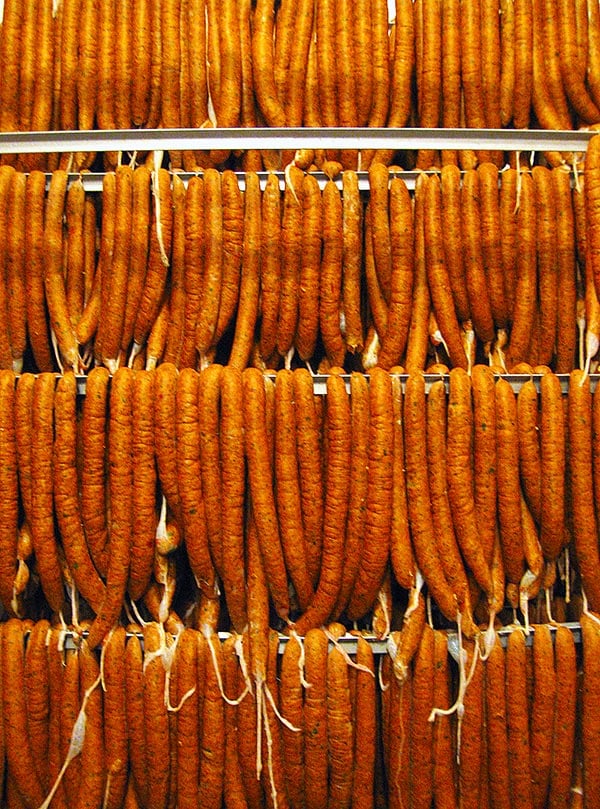
It may be possible to have a bad meal in Louisiana, but it hasn’t happened to me yet. Everything from shrimp out of the back of a van to the off-the-track little diners and restaurants to the palaces of New Orleans to mom-and-pop boucheries in Cajun Country, Louisiana is an eater’s paradise. Cajun boudin is not the least among the state’s culinary glories.
Louisiana boudin (boo-dan) is unlike French boudin, which is a more general term for sausages there. Cajun boudin is more like a meat stuffing packed into a hog casing and poached, grilled or smoked.
Some people eat it by squeezing out the good stuff from the casing — sometimes onto a cracker (Saltines appear to be the general cracker of choice), squirting some mustard on it and sitting on the back of your tailgate munching away and pondering the mysteries of life and sausages. Many others skip the crackers and just eat boudin like a meaty pop-up popsicle.
Boudin is a meal in a bite: Meat, fat, carbs from the rice, lots of vegetables and plenty of spice. Like dirty rice in a casing. It’s Cajun fast food.
If you are a hunter or an angler, boudin is a dish you need to know about, because Louisiana boudin can (and is) made from pretty much anything. Pork yes, but also duck (as I did in this version), venison, rabbit, alligator, chicken, crawfish, shrimp, crabs, nutria, quail, turkey… you get the point.
And since you grind everything, it’s a fantastic way to use the wobbly bits like livers, gizzards and hearts. You won’t really notice they’re in the boudin, and you get the satisfaction of a) not wasting parts of the animals you’ve hunted, and b) telling your offal-hating friends what they just ate — after they’ve eaten seconds. Or thirds.
How do you make this wondrous sausage?
I honestly had no idea until I got a chance to tour Cajun Country as the guest of the folks from Tabasco a few years ago. Among other things, they introduced me to Legnon’s Boucherie in New Iberia. Ted Legnon is famous both for his cracklins’ and his boudin, but I honestly can only eat a few crackin’s at any one time. I can eat inordinate amounts of boudin, so I focused my attention to that.
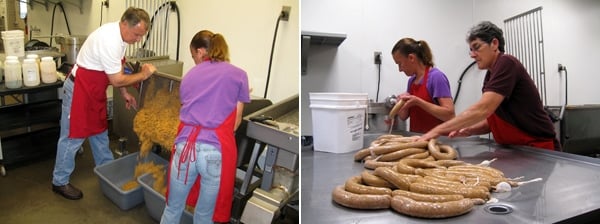
Boudin is a cooked sausage, in that everything is cooked before it’s ground up and stuffed into a casing. They’re sold in long links that are often tied into a ring and either poached and served or smoked to be eaten on the go. It’s a sloppy mixture that is only loosely stuffed into the casings — very unlike the tight stuffing you do with German sausages to get that characteristic knacken or snap.
Ratios of meat to rice vary; Legnon’s goes for a 1:1 ratio. My recipe is a little more meat-heavy.
The sausage can be mild or very spicy, with lots of vegetables (usually the “trinity” of onions, celery and green peppers) or few, red with paprika or just a humble gray. The point is that everyone makes boudin differently, and I’d be insane to claim that my recipe is definitive.
But I did learn from Legnon’s and I’ve eaten an awful lot of boudin, so I can tell you that my boudin is at least in the ballpark, even if it’s different from how your grandma or your local boucherie makes it.
If your boudin is different, how so? I’d be interested in hearing your variations.
New to making sausage? You can find my detailed tutorial on how to make sausages at home here.
Louisiana Boudin Sausage
Ingredients
- 1 1/2 pounds duck, venison, beef, pork, whatever
- 1/2 pounds liver
- 1/2 pound pork fat
- 1 large onion, chopped
- 2 celery stalks, chopped
- 2 poblano or green bell peppers, chopped
- 1 bay leaf
- 6 garlic cloves, chopped
- 1 tablespoon kosher salt
- 1/2 teaspoon Instacure No. 1 (optional)
- 3 to 5 tablespoons Cajun seasoning, or see below
- 2 cups cooked white rice (long-grain is best)
- 1 cup parsley, chopped
- 1 cup green onions, chopped
- Hog casings
Instructions
- Chop the meats, liver and fat into chunks that will fit in the grinder. Mix the meats, liver and fat with the onion, celery, poblano peppers and garlic, then the salt, curing salt (if using) and either the Cajun seasonings or the spice mix you made from this recipe. Put it all in a lidded container and set in the fridge at least an hour, and up to a day.
- Put the contents of the container into a large pot and pour in enough water to cover everything by an inch or two. Bring to a simmer and cook gently until everything is tender, at least 90 minutes and up to 3 hours. Strain the cooking liquid (you’ll need it later) and spread the meat, fat and veggies out on a sheet pan to cool.
- When everything is cool enough to handle, grind it through the coarse die (6.5 mm) on your grinder. You can also hand chop everything.
- Put your meat mix into a large bowl and add the cooked rice, parsley and green onions. Mix well, and add up to 4 cups of the reserved cooking liquid. Mix this for 3 to 5 minutes so you make a more cohesive mixture to stuff into a casing. You now have boudin.
- You can just shape the mixture into balls and fry them (they're awesome), or use your boudin as stuffing for something else, like a turkey. Or you can case it. Stuff the boudin into hog casings, and while you're doing it, get a large pot of salted water hot — not simmering, just steaming. You want the water to be about 165ºF to 170ºF. Poach the links for 10 minutes, then serve. If you are not serving them right away, no need to poach the links yet.
- Boudin does not keep well, so eat it all within a couple days. It does freeze reasonably well, however.
Notes
- A word on salt. I am assuming you are using a commercial Cajun seasoning mix, which will almost always be salty. So if you have a seasoning mix without salt in it, increase the plain salt to 2 or even 3 tablespoons.
Nutrition
Nutrition information is automatically calculated, so should only be used as an approximation.
HOMEMADE CAJUN SEASONING
Make this if you can’t find store-bought Cajun seasoning. It’s a little different from my normal spice mix, but it’s reflective of what you often find in boudin. If you want a redder sausage, increase the paprika. If you want it less spicy, reduce the cayenne.
- 1 tablespoon ground black pepper
- 1 tablespoon ground white pepper
- 1 tablespoon cayenne
- 1 tablespoon sweet paprika
- 1 teaspoon dried oregano
- 1/2 teaspoon celery seed

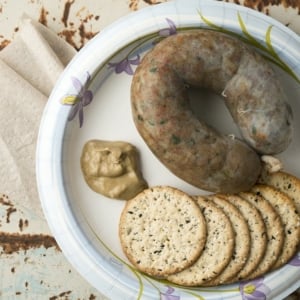
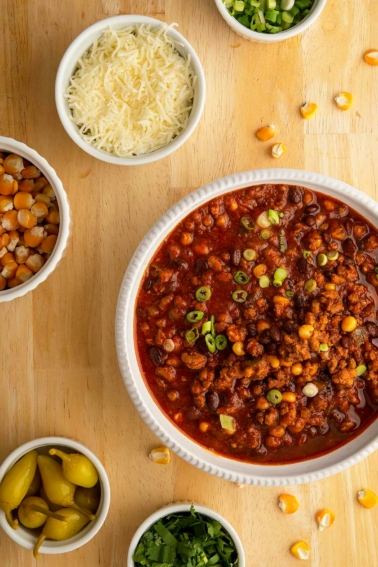
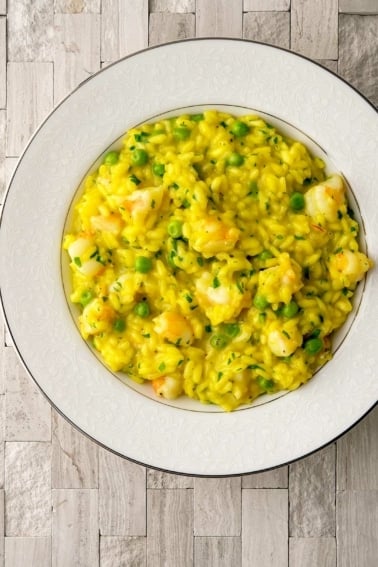
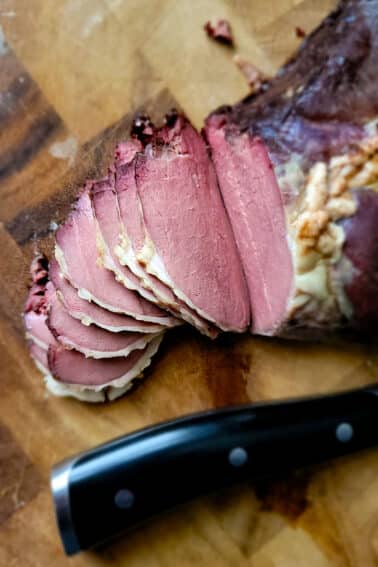
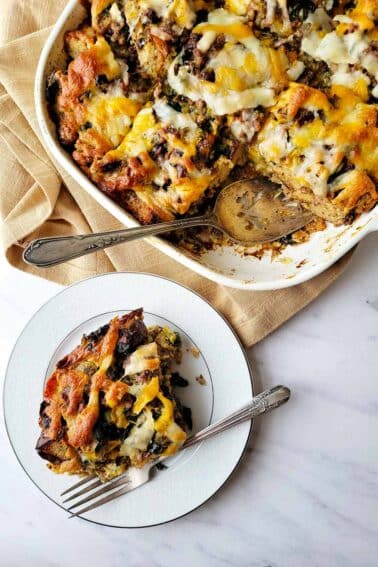
What size casings are preferred here?
Hemmingway: Anything you want. But if you have options, a wider hog casing is ideal.
I should have added this:
I make the croquettes by pressing boudin into the bottoms of muffin tins, and try to keep the thickness of each croquette to only 1/2 to 3/4″.
Here’s another option:
I enjoy making uncased boudin, any version, into croquettes, pan-frying in butter to put a crust on them, and then serving them as a side dish to some blackened fish.
Can even drizzle with dabs of left-over etoufee or remoulade.
Not traditional, but good, I gair-on-tee.
As a Louisianan I agree with everything you said about our Boudin Sausage. I can tell you are a real fan. Have you tried the variants? Crawfish or Alligator Boudin? There is one I am sure you will enjoy. Come back to Louisiana during Mardi Gras and seek out the Boudin stuffed King Cake.
What should I use to smoke it? Pecan wood
Todd: Pecan or oak would be my first choices.
I would like to use your receipt for boudin but the receipt for the spices don’t tell you how much pork to use with the different amounts of season. Could you please advise. Thank you
Larry: It’s the first three ingredients: meat, liver and fat. Pork is just one of the meats you can use.
Hi,
So glad I found you? I usually make my traditional dirty rice with pork, ground meat, chicken livers and veggies and lots of homemade Cajun spices. I’m new to links, how long are boudin links normally and would shrimp or crawfish in your opinion taste good with that blend?
Kate: Yes, both are variations you can find in Louisiana. The links are as long as you want. I usually see them about a foot long.
Hi, Hank- I have alpha-gal syndrome (thanks, outdoorsiness!), so I was planning on using duck fat instead of pig. Will that work, do you think, or is it too soft?
Hank, I was wondering if I could cook like 6 to 10lb of meat and upping all the other ingredients that goes in the meat then then grind and freeze with some broth. When ready to case a pound or two, add the rice and green onion mix and case. Wonder how that would work out?
Hi Hank, Pig liver is very difficult for me to source, so planning to use chicken livers. Would beef/calves liver be OK.
Hi Joe, I’m pretty sure you can use just about any kind of liver. (not polar bear, it’s poisonous, LOL) I just don’t like beef liver; I would use chicken or turkey livers if I couldn’t get pork. I’m not sure I’ve ever eaten calves liver but it would certainly work and might be milder-tasting than mature beef liver. HTH
I have some gator I’m going to use for this. I was wondering:
A) should I add the pork if I’m using gator?
B) what are your thoughts about adding waterfowl Offal to the mix?
Don: I typically do add some fat to the mix with boudin. As for gator + waterfowl offal, I dunno. They might clash, or they might be OK. My instinct says not to mix them.
If you are smoking it right away, why do you need to use the quick cure?
I’m confused also.
When he says “smoked” are we smoking, slow cooking, beside a brisket or ribs <225°) or are we cold smoking (100°) as we would other link sausages, cured bacon slabs, hams?
Is the cure incorporated into the ingredients as summer sausage and pepperoni or simply dusted with it to dry the casings before smoking?
How much cure to use?
It's cooked already. The casings were packed in a brine. Perhaps its to dry and crispy the casing so it can be bitten off, without further cooking, as a smoked backpacking food.
Ed: I am guessing you’ve never eaten Louisiana boudin then. 1) the amount of cure is clearly stated: 1/2 teaspoon. 2, it’s use is clearly stated in the first step. It is mixed in. 3, it is virtually impossible to cold smoke in a home setting. 99% of all smoking done in the United States is hot smoking, so yes, you would smoke the links a couple hours at “cool” temps, but still over about 165F. I typically smoke boudin at about 185F for between 2 and 3 hours. As you have guessed, everything is cooked, so smoking is just to add some extra flavor. Hope this answers your questions.
Hank,
Would you ever consider using deer liver in combination with venison? Should I? I’ve never used it myself and do not know if there is a major difference in taste as compared to beef or pork liver. The deer I would be using is on a strict farm crop diet (corn, beans, alfalfa, etc…).
Thanks
Tim: Absolutely. I like to soak deer liver in milk and or a salt brine before using in a recipe like this one. Takes out most of the smell. I’d cut the liver into chunks then soak in the fridge overnight in 1/4 cup sea salt to 1 quart water. Then, rinse and if you want, another day in milk.